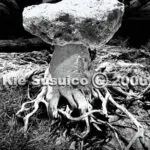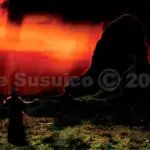Graphic Arts
Table of Contents
Share This
New medium for cultural artistic expression
Although a relatively new form of art, graphic arts on Guam became a common medium for cultural and artistic expression as modern technology became more accessible to the general public. Ancient Chamorro paintings, or pictographs, found in caves depict their lives and offer a glimpse of how the ancient island people viewed and interpreted the world around them.
Thus, cultural expression in form of graphics can be traced back to the Ancient Chamorro era.
Art creating culture creating art
As technology continues to evolve, technical tools make it easier to apply graphic arts as a more common form artful expression and cultural expression. In western societies art is most commonly seen at museums and galleries. In contrast, many non-western cultures produce forms of art that are interwoven in their social fabric.
On an island whose culture lies in the middle of traditional-modern continuum, graphic arts have recently enmeshed itself in cultural expression. For example, many business establishments provide graphic design services ranging from posters, web graphics, tee-shirts, announcements, brochures, and the like. Very apparent in this graphic design are cultural expressions and portrayal unique to Guam. Several locally owned tee-shirt business recreate and adopt the ancient Chamorro cave drawings.
Local artists and graphic artists
One of the most well-known cultural graphic arts was created by Kie Susuico and became a poster cover for Isla Center for the Arts’ Art of the Pacific Rim in Fall of 2006. His black-and-white graphic design caught many eyes as it depicts a latte, or a stone pillar with a capstone, used as foundations for ancient Chamorro houses, with roots extending from the stone. It was selected by an off-island juror as an official entry for the biennial art exhibition.
At present, graphic design is not limited to those artists who formally studied this relatively new art form. As graphic design software has became less expensive, it became accessible to the masses. The availability of this software allows many to try and experiment with juxtaposition of local colors.
Ron Castro is perhaps one of the most established graphic artists on island. He is a graduate of Art Institute of Pittsburg with his specialty being visual communications and graphic design.
For the past twenty years, Castro has painted and done other special projects with an emphasis on promoting Chamorro culture. In an effort to expose the young to Chamorro culture he created a multimedia project spotlighting Guam’s master traditional folk artists such as master weavers, master in Chamorro dance, master in Chamorro chant, among others. This graphic arts project can be seen on posters in many establishments on Guam.
Ariel Dimalanta is another established graphic artist with more than three decades of experience. Dimalanta was born on Guam, but received his grade-school through high-school education in the Philippines before returning to Guam in 1972. He then worked for the Pacific Daily News in 1973 as an advertising layout artist in the newspaper’s production department. Shortly afterward, Dimalanta and his siblings founded local ad agency, Admasters, producing ads for such ventures as local housing developments—including Baza Gardens, Barrigada Heights and Latte Heights—and private businesses as well as political campaigns and government projects.
From 1975 through 1979, Dimalanta left Guam to pursue a degree in the field of commercial arts. He attended the Academy of Arts College in San Francisco, the California College of Arts and Crafts, Oakland, California and a film school in Half Moon Bay, California. When he completed his education, Dimalanta returned to Guam and started his own marketing/advertising design studio, Ariel & Co.
Over the years, Dimalanta has created notable works including logo designs and illustrations for local companies catering to both Guam residents and Japanese tourists. He created the Guam Island Guide Map, a user-friendly visitors’ guide used by Guam visitors, both military and tourists. Dimalanta has won many awards for his work, including the design for Guam’s 2000 US Census poster. Currently, Dimalanta’s design work is featured in the Only On Guam Guide-Magazine, a quarterly guidebook committed to showcasing Guam in its entirety to newcomer audiences.
By Julius Sotomayor Cena
For further reading
Feldman, Jerome, and Donald H. Rubinstein. The Art of Micronesia: The University of Hawaii Art Gallery. Honolulu: University of Hawai’i Department of Art and Partners, 1986.
Kihleng, Kimberlee S., and Nancy P. Pacheco, eds. Art and Culture of Micronesian Women. Mangilao: Isla Center for the Arts and Women & Gender Studies Program, University of Guam, 2000.



